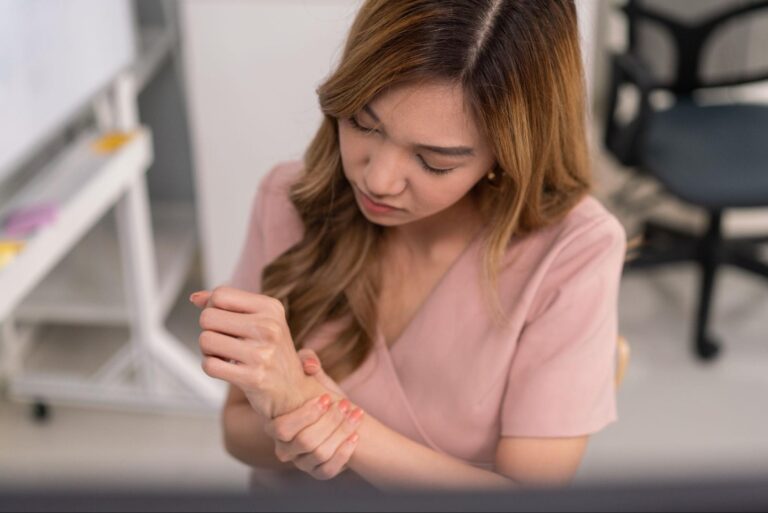Are your daily habits and routines silently contributing to a potentially debilitating condition? Carpal tunnel syndrome (CTS), a common ailment affecting the hands and wrists, often stems from the repetitive motions and postures we barely give a second thought to.
In this blog post, we’ll delve into the everyday activities that may be putting you at risk for CTS and discuss how simple changes could prevent or alleviate symptoms. We’ll also introduce you to a minimally invasive treatment option that may provide a quicker, less painful recovery, potentially transforming the way CTS is managed.
If you are already experiencing the tell-tale signs of CTS, this post is designed to guide you through understanding the risks, recognizing early symptoms, and exploring advanced treatment options.
Understanding Carpal Tunnel Syndrome (CTS)
Carpal tunnel syndrome (CTS) is a condition characterized by numbness, tingling, or weakness in the hand, arising from pressure on the median nerve as it travels through the wrist at the carpal tunnel. This pressure can be due to a variety of factors, including swelling, anatomical differences, or repetitive motions. Symptoms typically start gradually and can include sensations of pins and needles, particularly in the thumb, index, middle, and ring fingers, often prompting individuals to shake out their hands for relief.
The diagnosis of CTS usually involves a combination of a patient’s history, physical examination, and sometimes, confirmatory ultrasound or nerve conduction studies. The prevalence of CTS is significant, with the condition impacting a wide range of people, from office workers and manual laborers to pregnant women.
The impact of carpal tunnel syndrome on daily life can be profound, affecting the ability to perform simple tasks, work efficiently, and enjoy hobbies without discomfort or pain.
Daily Activities That May Increase the Risk of CTS
Daily activities that involve repetitive hand movements and sustained postures can increase the risk of developing carpal tunnel syndrome. Such activities include typing, using hand tools, and playing musical instruments.
Additionally, certain lifestyle factors, such as high body mass index (BMI), smoking, and a sedentary lifestyle, can also contribute to the development of CTS. It’s important to recognize these risk factors and take preventative measures to reduce the chances of developing this condition.


Occupation
Repetitive hand and wrist movements are a common component of many workplace environments. Office workers who spend hours using a mouse or typing on a keyboard, assembly line workers performing the same motions throughout their shifts, and baristas repeatedly making coffee are all subject to the repetitive strain that can lead to carpal tunnel syndrome. Likewise, actions such as that of hair stylists and barbers, who are constantly using scissors and styling tools, can lead to repetitive strain.
Constant use of hand tools such as scissors and hair styling tools, wrenches and screwdrivers, and surgical tools can all lead to repetitive strain on the hands and wrists.
Poor ergonomics can exacerbate the risk of CTS, with improperly adjusted workstations, chairs without armrests, or tools that require excessive force increasing strain on the wrist and hand. Typing at the wrong angle can bend your wrist too far up or down causing strains to the median nerve.
Hobbies
Even outside the workplace, daily activities such as gardening, knitting, or excessive smartphone use may contribute to the development of CTS by putting consistent pressure on the median nerve in the wrist.
Art enthusiasts such as painters and sculptors who work with their hands for long periods of time may experience strain on their wrists and fingers. Likewise, musicians playing musical instruments, especially those that require intricate finger movements, can contribute to the development of carpal tunnel syndrome.
Some sports that involve high wrist and hand use, such as golfing, tennis, and racquetball, can increase the risk of developing carpal tunnel syndrome due to the repetitive motions and sustained postures involved in these activities.
The constant gripping and swinging motions in these sports can put strain on the wrist and hand, potentially leading to symptoms of CTS over time.
It’s important for individuals engaging in these extracurriculars to be mindful of their hand and wrist positioning and take preventative measures to reduce the risk of developing the condition.
Lifestyle
Lifestyle factors, including high body mass index (BMI), caffeine, alcohol intake, smoking, and a sedentary lifestyle, can also heighten the chances of developing CTS.
Obesity can cause underlying health conditions such as diabetes or arthritis, increasing the risk of getting CTS. Maintaining a healthy weight through diet and exercise can help decrease the risk of carpal tunnel syndrome.
Excessive alcohol consumption and high levels of caffeine intake can contribute to the development of CTS by impairing nerve function, increasing inflammation and swelling, and reducing flexibility and blood flow in the wrist.
Smoking can affect blood circulation and limit oxygen flow to the nerves and tendons in the hands and wrists, increasing the risk of inflammation and compression of the median nerve.
Recognizing and modifying these daily activities and habits can be crucial steps in reducing the risk of experiencing the pain and mobility issues associated with carpal tunnel syndrome.
Recognizing the Early Signs of CTS


Recognizing the early signs of carpal tunnel syndrome is crucial for timely diagnosis and treatment.
Symptoms often start gradually and can include tingling, numbness, and pain in the thumb, index, and middle fingers. Ignoring these warning signs can lead to persistent discomfort and potential long-term nerve damage.
Individuals experiencing such symptoms should seek medical advice, especially if the sensations persist or worsen. Early intervention is key to managing the condition effectively. Simple self-assessment techniques, like checking for weakness in the thumb’s pinching strength or observing if shaking the hand reduces discomfort, can help individuals recognize potential CTS. These self-checks, however, are not a substitute for professional medical evaluation.
Take A Symptom Survey
Preventative Measures to Reduce the Risk of CTS
Exercises and stretches specifically designed for the hands and wrists can play a crucial role in preventing carpal tunnel syndrome. Incorporating such activities into your daily routine can enhance flexibility, reduce stiffness, and strengthen the muscles surrounding the carpal tunnel.
Regularly performing these exercises can mitigate the strain repetitive motions place on the wrist, thereby lowering the likelihood of developing CTS.
Improving workplace ergonomics is another effective strategy to prevent CTS. Ergonomic adjustments may include aligning your workstation to ensure that your wrists are in a neutral position while typing or using a mouse, and utilizing supportive devices such as wrist rests and ergonomic keyboards.
These modifications help maintain proper hand posture and reduce the pressure exerted on the median nerve.
Treatment Options for Carpal Tunnel Syndrome

Treatment options for carpal tunnel syndrome (CTS) are varied, ranging from conservative to more invasive procedures.
In the initial stages, doctors often recommend wrist splints to immobilize the hand during activities that exacerbate symptoms or while sleeping. Nonsteroidal anti-inflammatory drugs (NSAIDs) may be prescribed to manage pain and reduce inflammation.
For those with persistent symptoms, corticosteroid injections can provide temporary relief by decreasing swelling around the median nerve.
When conservative treatments fail to provide lasting relief, surgery becomes a consideration. The traditional surgical approach, known as carpal tunnel release, involves cutting the ligament that forms the roof of the carpal tunnel to relieve pressure on the median nerve.
While effective, this surgery can require a lengthy recovery and may result in significant postoperative pain. Non-invasive therapies, such as physical therapy, may also be recommended to improve hand and wrist function. These treatments aim to reduce symptoms without the need for surgery but may not be sufficient for severe cases.
Introducing Carpal Tunnel Release With UltraGuideCTR™ and Real-Time Ultrasound Guidance
Carpal tunnel release with ultrasound guidance using UltraGuideCTR™ is a minimally invasive treatment option for carpal tunnel syndrome. While individual results may vary, this technique is designed to alleviate the debilitating symptoms associated with CTS with shorter recovery times, allowing patients to quickly return to their daily routines.1-4 Unlike traditional surgical options, this option utilizes ultrasound guidance to target and treat the affected area.
The benefits of opting for carpal tunnel release with ultrasound guidance include a reduced risk of complications, minimal scarring, and a shorter rehabilitation period compared to traditional surgeries.1-6 Patients typically experience a reduction in recovery time, which can be particularly appealing for those eager to resume work and personal activities, but individual results may vary.
Testimonials from individuals who have undergone this technique underscore these advantages, with many reporting prompt relief from CTS symptoms and a rapid return to their pre-condition quality of life. Please discuss the risks and benefits of this procedure with your healthcare provider to determine if it would be a good choice for you.
Ready to Alleviate the Discomfort of CTS?
As we’ve explored the daily actions and habits that might be putting us at risk for carpal tunnel syndrome, it’s clear that awareness and proactive measures are key to managing and preventing this common yet debilitating condition. If you’re experiencing symptoms or want to safeguard your wrist health, remember it’s essential to take action now rather than later.
Get A Free Screening
With its minimally invasive approach and rapid recovery times, it stands out as a considerable option for those seeking relief from carpal tunnel syndrome. You deserve to return to your normal, pain-free activities as quickly as possible.
Don’t let carpal tunnel syndrome slow you down. Reach out to your healthcare provider and ask about carpal tunnel release with ultrasound guidance technique using UltraGuideCTR™, or explore the FAQ section of our website for more information on how we can help you achieve swift and effective symptom relief.
Take the step today for a healthier, more comfortable tomorrow and get a free screening to see if carpal tunnel release with ultrasound guidance is right for you.
MP04169rA





